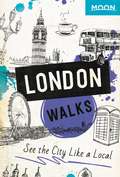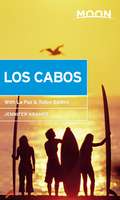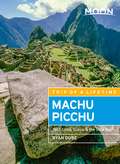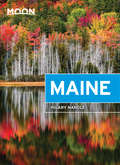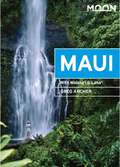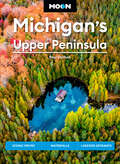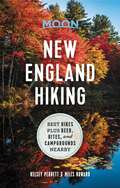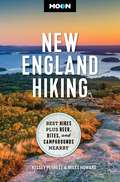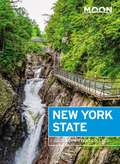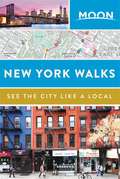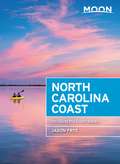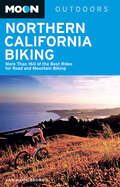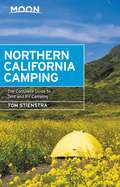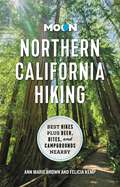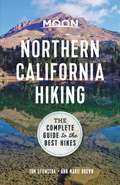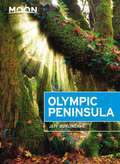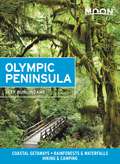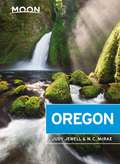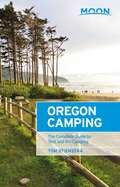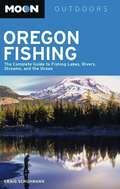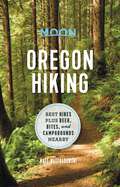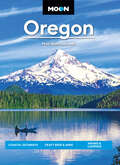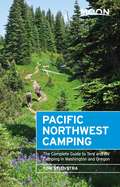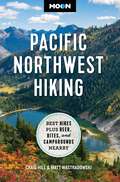- Table View
- List View
Moon London Walks: See the City Like a Local (Travel Guide)
by Moon Travel Guides<p>Whether you're shopping on the high street, strolling lively street markets, or admiring renowned modern art, experience London like a local: on foot!<p> <p>Walk through the city's coolest neighborhoods like Shoreditch, Chelsea, Marylebone, and more, with color-coded stops and turn-by-turn directions<p> <p>Find your scene with top ten lists of the best restaurants, nightlife, markets, museums, and more<p> <p>Get to know the real London on six customizable walks: Find funky vintage treasures in Shoreditch or treat yourself at an upscale department store like Harrods. Make your way to the Tate Modern and other world-famous art galleries, take in London's history at Westminster Abbey, and watch the changing of the guards at Buckingham Palace. Take a leisurely stroll through Regent's Park, enjoy afternoon tea at a stylish hotel, or grab a pint and some fish and chips before heading to the theatre. Sip craft cocktails in an old train station, discover the hippest new gastropub, or watch the sun set over the city from a chic rooftop bar<p> <p>Escape the crowds at locally-loved spots and under-the-radar favorites<p> <p>Explore on the go with foldout maps of each walking route and a removable full-city map, all in a handy guide that fits in your pocket<p> <p>With creative routes, public transit options, and a full-city map, you can experience London at your own pace without missing a beat.<p>
Moon Los Cabos: With La Paz & Todos Santos (Travel Guide)
by Jennifer KramerLos Cabos is synonymous with luxury and relaxation, but the best of Baja starts just beyond the resorts. Dive into the real Mexico with Moon Los Cabos. Inside you'll find:Flexible itineraries, from four days of waves, tacos, and sunshine to a road trip through Baja Sur, along with the best beaches for relaxing, diving, snorkeling, and surfing Strategic advice for road-trippers, foodies, surfers, hikers, and moreTop activities and unique experiences: Explore mountain ranges, secluded beaches, and gorgeous waterfalls, or snorkel through pristine coral reefs. Drink margaritas in a beach-front cabaña, sip a cerveza from your hammock, or spot humpbacks, whale sharks, and sea lions. Savor the crispiest fish tacos, dance until dawn at a local favorite bar, or relax on the sand with a beach read Expert insight from local tour guide Jennifer Kramer, who's spent nearly 30 years immersed in Baja, on where to eat, how to get around, and where to stay, from beach bungalows to luxurious resortsFull-color photos and detailed maps throughout Reliable background information on the landscape, climate, wildlife, and history, as well as common customs and etiquette Handy tools including a Spanish phrasebook, packing suggestions, and travel tips for families with kids, seniors, travelers with disabilities, and LGBTQ travelersGo beyond the resorts and experience the best of Baja with Moon Los Cabos' practical tips and local insight.Hoping for más Mexico? Check out Moon Baja, Moon San Miguel de Allende, or Moon Mexico City.
Moon Machu Picchu: With Lima, Cusco & the Inca Trail (Travel Guide)
by Ryan DubéMystical, timeless, and full of adventure: embark on the trip of a lifetime to the jewel of Peru with Moon Machu Picchu. Inside you'll find:Strategic trekking guides, including two to four days on the Inca Trail, five days on the Salcantay, and an Inca Jungle Trail itinerary, plus focused coverage of Cusco, the Sacred Valley, and LimaUnique experiences beyond the beaten path: Explore seldom-seen ruins like the Ollantaytambo Temple and visit remote Quechua-speaking villages. Go horseback riding on a caballo de paso in the Sacred Valley, mountain biking to the hilltop fortress of Sacsayhuamán, or set up camp on the riverbank after a day of rafting on the Río Apurímac. Sample coca tea and authentic local delicacies, or shop for handmade Peruvian weavings, pottery, and jewelryEssential planning information on agencies, tour guides, and porters, food and accommodations, packing suggestions, finding the best airfares, and getting around by bus, train, taxi, car, or motorcycle rentalHow to visit Machu Picchu respectfully, with tips from Lima local Ryan Dubé on and helping the local economy, minimizing your impact, and avoiding over-tourism A guide to hazards, precautions, and gear, including how to avoid altitude sicknessFull-color photos and easy-to-use maps throughout, plus a convenient foldout mapThorough background information on the landscape, wildlife, plants, culture, history, and local customsHandy tools including a Spanish phrasebook, visa information, volunteer and study opportunities, and tips for seniors, families, visitors with disabilities, women traveling alone, and LGBTQ+ travelersWith Moon Machu Picchu's practical advice and insider know-how, you can forge your own path.Doing a tour of South America? Try Moon Cartagena & Colombia's Caribbean Coast, Moon Ecuador & the Galápagos Islands, or Moon Chile.
Moon Maine (Travel Guide)
by Hilary NangleExplore the spruce-studded mountains, classic shoreline villages, and rugged character of the Pine Tree State with Moon Maine. Inside you'll find:Strategic itineraries ranging from an eleven-day road trip through the whole state to a week exploring the coast, with ideas for every seasonMust-see highlights and unique experiences: Sample wild blueberries, farmstead cheeses, and preserves from roadside farmers' markets or find the best beachfront lobster shack. Trace picturesque lighthouses down the coast, stop to smell the roses at the botanical gardens, and taste some of Maine's best wines, craft beer, and mead. Watch the boats sway in a quiet harbor, mingle with locals over a "chowdah suppah," and unwind on a sandy pocket beachOutdoor adventures: Hike through majestic timberland forests or summit the peak of Katahdin on the final stretch of the Appalachian Trail. Take a moose safari, experience the rush of whitewater rafting, or ski the slopes at Sugarloaf. Canoe down the Allagash, paddle a sea kayak along the serpentine coastline, and immerse yourself in the secluded wilderness of Acadia National ParkHonest advice from born-and-raised Maine local Hilary Nangle on when to go, where to eat, and where to stay, from luxury hotels and historic inns to budget campgroundsFull-color photos and detailed maps throughoutEssential information including background on Maine's landscape, climate, wildlife, and cultureWith Moon Maine's practical tips and local insight, you can experience the best of the state.Hitting the road? Try Moon New England Road Trip. If you're headed north, try Moon Nova Scotia, New Brunswick & Prince Edward Island or Moon Montréal.
Moon Maui: With Molokai & Lanai (Travel Guide)
by Greg ArcherEndless stretches of golden sand, legendary surf, and epic outdoor experiences: Discover the true spirit of aloha with Moon Maui. Inside you'll find:Flexible itineraries, from your best day in each region to a ten-day Maui adventure, with coverage of neighboring islands Moloka'i and Lana'iStrategic advice for backpackers, beach-lovers, adventurers, honeymooners, families, wellness-seekers, and moreOutdoor adventures like kayaking, hiking, and scuba-diving, plus the best beaches for swimming, surfing, and snorkelingTop activities and unique experiences: Drive the famous 30-mile Road to Hana or bike through misty hidden valleys. Hike through thick bamboo forests to thundering waterfalls or to the top of a dormant volcano. Snorkel with giant green sea turtles, learn how to catch the perfect wave, or embark on a whale-watching tour. Soak up the electric energy of Front Street in Lahaina, unwind at a luxurious spa, or relax on the sand and watch the sunset with a mai tai in hand The best local flavors: Chow down on fresh fish tacos from a local food truck, savor Polynesian cuisine, and sip coconut porter beer at Hawaii's largest breweryExpert insight from Maui local Greg Archer on how to experience the island like an insider, support local and sustainable businesses, avoid crowds, and respectfully engage with the cultureFull-color photos and detailed maps throughoutBackground information on Maui's landscape, history, and cultural customsHandy tools including a Hawaiian phrasebook, packing suggestions, and travel tips for international visitors, families with kids, seniors and LGBTQ travelersWith Moon's practical tips and local know-how, you can experience the best of Maui.Hitting more Hawaiian Islands? Try Moon Big Island of Hawai'i, Moon Kaua'i, and Moon Honolulu & O'ahu. Visiting all of them? Check out Moon Hawaii.
Moon Michigan's Upper Peninsula: Scenic Drives, Waterfalls, Lakeside Getaways (Moon U.S. Travel Guide)
by Paul Vachon Moon Travel GuidesMake the most of the natural beauty and adventurous spirit of the "U.P.," from vast aquamarine waters to charming upland towns, with Moon Michigan's Upper Peninsula. Inside you'll find:Strategic, flexible itineraries, whether you want to see the best of the peninsula in a week or two or spend a long weekend on Mackinac Island Top experiences and things to do: Relax in a cozy lake lodge or a grand Victorian-style hotel, sample local vintages at U.P. wineries, kick back at an outdoor summer concert, or tour dozens of picturesque lighthouses. Indulge in local delicacies like Cornish pasties, Swedish meatballs, and Mackinac Island fudge. Wander around the country's best-preserved ghost town or watch costumed interpreters reenact battles at historic military sites Best outdoor adventures for every season: Hike past colorful maple forests and rushing waterfalls, and spot wild moose, red foxes, and white-tailed deer. Trot through flower-filled meadows on horseback or cycle through history on a bike tour. Spend a summer day boating, fishing and swimming, or go skiing, snowshoeing, or snowmobiling on a winter afternoon Expert advice on when to go, where to stay, and how to get around from lifelong Michigander Paul Vachon Full-color photos and detailed maps throughoutThorough background information on the landscape, climate, wildlife, and local culture Experience the best of the Upper Peninsula with Moon. Exploring more of the Great Lakes State? Try Moon Michigan.About Moon Travel Guides: Moon was founded in 1973 to empower independent, active, and conscious travel. We prioritize local businesses, outdoor recreation, and traveling strategically and sustainably. Moon Travel Guides are written by local, expert authors with great stories to tell—and they can't wait to share their favorite places with you. For more inspiration, follow @moonguides on social media.
Moon Nevada (Travel Guide)
by Scott SmithWhether you're an adventure junkie, road-tripper, or card shark, Nevada has something for you. Pull off the perfect trip to the Silver State with Moon Nevada. Inside you'll find:Strategic itineraries for road-trippers, campers, skiers, and moreThe best road trips through Nevada, from three days on "the loneliest road in America" to a week covering Death Valley and the Extraterrestrial Highway, plus detailed information on travel times, distances, and directionsThe top sights and unique experiences: Explore caves and glaciers at Great Basin National Park, or go fishing, swimming, or boating on Lake Tahoe or Lake Mead. Marvel at the Hoover Dam, camp at a secluded alpine lake, and experience the authentic Wild West in a ghost town saloon. Try your hand at a slot machine and eat your way through an epic Las Vegas buffet, or visit one of Nevada's major festivals and shop for local turquoise jewelry in a Gold Rush townLocal tips from longtime Nevadan Scott Smith on where to stay, when to go, and how to get around, plus advice for families with children and travelers with disabilitiesFull-color photos and detailed maps throughoutThorough background information on the landscape, climate, wildlife, and local cultureFocused coverage of Reno, Las Vegas, Death Valley, Tahoe, Central Nevada, Elko, the Ruby Mountains, and moreWith Moon Nevada's practical tips and local insight, you can plan your trip your way.Spending more time at the lake? Try Moon Tahoe. Headed to the parks? Try Moon Yosemite National Park or Moon Death Valley National Park.
Moon New England Hiking: Best Hikes plus Beer, Bites, and Campgrounds Nearby (Moon Outdoors)
by Moon Travel Guides Kelsey Perrett Miles HowardThe sands of Cape Cod, the peaks of the Maine Highlands, and the forests of Bear Mountain: wherever you turn in New England, adventure awaits. Pack a lunch, lace up your boots, and hit the trails with Moon New England Hiking. Inside you'll find:Diverse Hiking Options: From breathtaking seaside walks in Coastal Maine to challenging backcountry treks in the Berkshires, find 150 outdoor getaways ranging from easy day hikes to multi-day backpacking tripsFind Your Hike: Looking for something specific? Choose from strategic lists like the best spots for a swim, high-elevation vistas, New England oddities, and hikes with nearby breweries, plus a breakdown of the best hikes for each seasonThe Top Outdoor Experiences: Cool off under a cascading waterfall, pick wild blueberries from a meadow, and take in views of endless autumnal foliage. Take a dip in the ocean after scaling the cliffs in Acadia or meander through shorebird habitats in Rhode Island. Visit a replica of Thoreau's cabin at historic Walden Pond, enjoy a peaceful afternoon on a secluded trail, and marvel at the Boston skyline from afarNearby Fun: Relax after your hike at a local brewery, find a nearby campground, or stop for lunch at a mom n' pop eateryEssential Planning Details: Each hike is described in detail and marked with round-trip distance and hiking time, difficulty, terrain type, elevation gain, and access pointsMaps and Directions: Easy-to-use maps, driving directions to each trailhead, and details on where to parkFull-color photos throughoutExpert Advice: Seasoned hikers Miles Howard and Kelsey Perrett reveal their experienced insights, local secrets, and honest opinions of each trailTips and Tools: Advice on gear, first aid, protecting the environment, and getting park passes, plus background information on climate, landscape, and wildlife Moon New England Hiking covers Vermont, New Hampshire, Maine, Massachusetts, Rhode Island, and ConnecticutWhether you're a veteran or a first-time hiker, Moon's comprehensive coverage and local expertise will have you gearing up for your next adventure.Exploring the region? Check out Moon New England.
Moon New England Hiking: Best Hikes, Plus Beer, Bites, and Campgrounds Nearby (Moon Hiking Travel Guide)
by Moon Travel Guides Kelsey Perrett Miles HowardHit the trail and experience the best local adventures in Vermont, New Hampshire, Maine, Massachusetts, Rhode Island, and Connecticut with Moon New England Hiking! Inside you'll find:150 Outdoor Getaways including easy day hikes and multi-day backpacking trips Diverse Hiking Options from breathtaking seaside walks in Coastal Maine to challenging backcountry treks in the Berkshires Find Your Hike: Choose from strategic lists like the best spots for a swim, high-elevation vistas, New England oddities, and hikes with nearby breweries, plus a breakdown of the best hikes for each season The Top Outdoor Experiences: Cool off under a cascading waterfall, pick wild blueberries from a meadow, and take in views of endless fall foliage. Take a dip in the ocean after scaling the cliffs in Acadia or meander through shorebird habitats in Rhode Island. Visit a replica of Thoreau's cabin at historic Walden Pond, enjoy a peaceful afternoon on a secluded trail, and marvel at the Boston skyline from afar Nearby Fun: Relax after your hike at a local brewery, find a nearby campground, or stop for lunch at a mom n' pop eatery Essential Planning Details: Each hike is described in detail and marked with round-trip distance and hiking time, difficulty, terrain type, elevation gain, and access points Maps and Directions: Easy-to-use maps, driving directions to each trailhead, and details on where to park Full-color photos throughout Expert Advice: Seasoned hikers Miles Howard and Kelsey Perrett reveal their experienced insights, local secrets, and honest opinions of each trail Tips and Tools: Advice on gear, first aid, protecting the environment, and getting park passes, plus background information on climate, landscape, and wildlife Whether you're a veteran or a first-time hiker, Moon's comprehensive coverage and local expertise will have you gearing up for your next adventure. Exploring the region by car? Check out Moon New England Road Trip. About Moon Travel Guides: Moon was founded in 1973 to empower independent, active, and conscious travel. We prioritize local businesses, outdoor recreation, and traveling strategically and sustainably. Moon Travel Guides are written by local, expert authors with great stories to tell—and they can't wait to share their favorite places with you. For more inspiration, follow @moonguides on social media.
Moon New York State: Getaway Ideas, Road Trips, Local Spots (Travel Guide)
by Julie Schwietert CollazoFrom museum-hopping in the Hudson Valley to hiking the hills upstate, discover the New York you don't know with Moon New York State. Inside you'll find:Strategic itineraries ranging from a two-week road trip to weekend getaways from the city, with ideas for art-lovers, foodies, outdoor enthusiasts, foliage-seekers, and moreDay trips from New York City to Long Island, the Hudson Valley, and the CatskillsThe top sights and unique experiences: Explore the charming riverside towns of the Hudson Valley on a brewery trail, sample local wine and cheese upstate, or relax on the beaches of Montauk. Hike to a spectacular sunrise in the Catskills, kayak on the Finger Lakes, and peep the vibrant changing leaves in the Adirondacks. Browse the quirky boutiques of Lower Manhattan, stroll the High Line, and savor skyline views with a nightcap in hand at a rooftop barHonest advice from native New Yorker Julie Schwietert Collazo on when to go, where to stay, and how to get aroundFull-color photos and detailed maps throughoutThorough background on the history, culture, and geography of the stateRecommendations for families, LGBTQ travelers, seniors, international visitors, and travelers with disabilitiesWith Moon New York State's practical tips and local insight, you can experience the best of the Empire State.Want to experience NYC like a local? Check out Moon New York City.
Moon New York Walks
by Moon Travel GuidesExperience the Big Apple like a local: on foot!Moon New York Walks guides you to the trendiest restaurants, buzzworthy boutiques, and iconic landmarks of New York City's can't-miss neighborhoods. This full-color guide to "the city that never sleeps" features:Six customizable walks through the city's hippest neighborhoods, including Soho, the West Village, the Lower East Side, Williamsburg, and more, with color-coded stops and turn-by-turn directionsFoldout maps of each route and a removable full-city map, in a handy, portable guideCurated "Top Ten" lists for dining, arts and culture, nightlife, and (of course) coffee, for visitors looking to hit the highlightsThe top attractions and the best-kept local secrets: Stroll down Fifth Avenue past icons like the Flatiron, the Empire State Building, and Rockefeller Centre, or walk along the Hudson River and learn the history of jazz and the Harlem Renaissance. Take in jaw-dropping views along the High Line, shop for trendy trinkets in the Meatpacking District, and explore world-famous galleries and museums. Cross the Williamsburg Bridge, peruse a flea market, and discover hip coffee shops tucked among the Brooklyn warehouses. Sample authentic dumplings in Chinatown, old-school deli standbys, or healthy vegan treats. Sip craft cocktails in an underground speakeasy, or admire the city skyline from a rooftop barPublic transportation options, including the subway, bus, taxi, or bike rentalTips for first-time visitors, including seasonal festivals, where you'll need to make a reservation, and getting to and from the airportWith creative routes, public transit options, and a full-city map, you can explore New York at your own pace, without missing a beat.Check out our guides to more of the world's liveliest cities, so you can hit the ground running! Also available: Moon Barcelona Walks, Moon Berlin Walks, Moon London Walks, Moon Amsterdam Walks, Moon Paris Walks, and Moon Rome Walks
Moon North Carolina Coast: With the Outer Banks (Travel Guide)
by Jason FryeSalty air and the promise of adventure: answer the call of the ocean with Moon North Carolina Coast. Inside you'll find:Strategic itineraries, from a weekend getaway to the Outer Banks to a week covering the whole coast, designed for beach bums, outdoor adventurers, history buffs, families, and moreThe top sights and unique experiences: Visit the North Carolina Aquarium, explore a Civil War fort, discover the remains of sunken pirate ships, or climb to the top of a historic lighthouse. Order the catch of the day at a local fish shack, sample fresh oysters, or indulge in some authentic North Carolina barbecue. Relax on a sandy beach, spot wild horses on the shore, and watch the sun set over the glittering AtlanticOutdoor adventures: Kayak through misty marshes, take a moonlight paddling tour of a wildlife refuge, surf the powerful swells, or hike the largest sand dune on the East CoastThe best beaches for your trip, with lists of the top spots for sunbathing, water sports, wildlife viewing, solitude, and moreHonest insight from North Carolina local Jason Frye on when to go, where to eat, and where to stay, from rugged campgrounds to historic innsFull-color photos and detailed maps throughoutThorough background on North Carolina's culture, environment, wildlife, and historyWith Moon North Carolina Coast's diverse activities and local perspective, you can plan your trip your way.Exploring inland? Check out Moon North Carolina. Hitting the road? Try Blue Ridge Parkway Road Trip.
Moon Northern California Biking: More than 160 of the Best Rides for Road and Mountain Biking (Moon Outdoors)
by Ann Marie BrownAvid biker and experienced travel writer Ann Marie Brown knows the best places to cycle in Northern California, from steep ocean-front rides to meandering, scenic trails through Sonoma and Napa. Moon Northern California Bikingguides seasoned riders and beginning bikers to the best trails, paths, and roads throughout the San Francisco Bay Area, Tahoe, Yosemite, and Northern California wine country. Complete with elevation charts, route maps, and options to extend or shorten each route, as well as information on bike shops, riding clubs, and bike organizations throughout the region,Moon Northern California Bikinggives bicyclists the tools they need to create a more personal and memorable experience.
Moon Northern California Camping: The Complete Guide to Tent and RV Camping (Moon Handbooks)
by Tom StienstraWhether you're camping among towering redwoods, along rugged coastline, or in the High Sierra, you'll always find your perfect campsite with Moon Northern California Camping.A Campsite for Everyone: Pick the right tent or RV site with options ranging from secluded Sierra hike-ins to convenient roadside stopovers, including dog-friendly, family-friendly, and wheelchair accessible options, and strategic lists of the best campgrounds for hiking, swimming, and moreRatings and Essentials: All campgrounds are rated on a scenic scale and marked with amenities like restrooms, trailhead access, picnic areas, laundry, piped water, showers, and playgroundsRecreation Highlights: Discover nearby hiking, swimming, fishing, biking, water-skiing, white water rafting, and hot springsMaps and Directions: Easy-to-use maps and detailed driving directions for each campgroundSkip the Crowds: Moon Northern California Camping contains many secluded spots and campgrounds that aren't available in the state's online reservation systemTrailhead Access Campgrounds: Find sites that offer access to the John Muir Trail, the Pacific Crest Trail, and more, plus essential information on hikingExpert Advice: Expert outdoorsman Tom Stienstra knows his stuff; he's hiked 25,000 miles in and around these campgrounds for over 30 yearsTips and Tools: Information on equipment, food and cooking, first aid, and insect protection, plus background on the climate, landscape, and history of the campsitesWhether you're a veteran or a first-time camper, Moon's comprehensive coverage and local insight will have you gearing up for your next adventure.Exploring more of the Golden State? Try Moon California Camping. Looking for some focused advice on outdoor recreation? Check out Moon California Hiking.
Moon Northern California Hiking: Best Hikes Plus Beer, Bites, and Campgrounds Nearby (Moon Hiking Travel Guide)
by Ann Marie Brown Moon Travel Guides Felicia KempPack a lunch, lace up your boots, and head out to discover the rugged coastline, towering redwoods and best hiking trails in NorCal with Moon Northern California Hiking. Inside you'll find:Diverse Hiking Options: Whether you plan to take leisurely seaside walks or challenging journeys around the Sierras, enjoy outdoor getaways ranging from easy day hikes to multi-day backpacking trips Find Your Hike: Looking for something specific? Choose from strategic lists of the best hikes for breathtaking waterfalls, spring wildflowers, or hiking with your dog, plus a breakdown of the best hikes by season The Top Outdoor Experiences: Wander the terraces of the Ecological Staircase in Mendocino, hike up granite domes and through the high meadows of Yosemite. Hear the waves crash as you walk to a majestic tide fall in Point Reyes National Seashore. Conquer the summit of Lassen Peak, roam through vineyard-covered hills in Napa and Sonoma or look out upon Lake Tahoe's crystal waters. Nearby Fun: Relax post-hike at a local brewery, savor a plate of fresh oysters or stargaze before bed at a nearby campground Essential Planning Details: Each hike is described in detail and marked with round-trip distance and hiking time, difficulty, terrain type, elevation gain, and access points Maps and Directions: Find easy-to-use maps, driving directions to each trailhead, and details on where to park Expert Advice: Longtime hikers Ann Marie Brown and Felicia Kemp shares their local secrets, unique tips, and honest opinions of each trail Tips and Tools: Advice on gear, first aid, and camping permits, plus background information on climate, landscape, and wildlife Whether you're a veteran or a first-time hiker, Moon's comprehensive coverage and local expertise will have you gearing up for your next adventure.About Moon Travel Guides: Moon was founded in 1973 to empower independent, active, and conscious travel. We prioritize local businesses, outdoor recreation, and traveling strategically and sustainably. Moon Travel Guides are written by local, expert authors with great stories to tell—and they can't wait to share their favorite places with you. Hitting the road? Check out Moon Northern California Road Trips!
Moon Northern California Hiking: The Complete Guide to the Best Hikes (Moon Outdoors)
by Ann Marie Brown Tom StienstraPack a lunch, lace up your boots, and head out to discover the best hiking trails in NorCal with Moon Northern California Hiking.A Hike for Everyone: Pick the right hike for you, from breathtaking coastal walks to challenging backcountry treks, with options ranging from easy day hikes to multi-day backpacking tripsBest Hikes Lists: Choose from strategic lists like the best hikes for majestic redwoods, bird-watching, refreshing swimming holes, wheelchair accessibility and moreEssential Planning Details: Each hike is marked with round-trip distance and hiking time and rated for scenic beauty and trail difficultyMaps and Directions: Find easy-to-use maps, driving directions to each trailhead, and details on where to parkSkip the Crowds: Have the trail to yourself with Moon Northern California Hiking's many off-the-radar hikesExpert Advice: Seasoned hikers Tom Stienstra and Ann Marie Brown offer their experienced insight and honest opinions on each trailTips and Tools: Advice on gear, first aid, ethical hiking, and camping permits, plus background information on climate, landscape, and wildlifeWhether you're a veteran or a first-time hiker, Moon's comprehensive coverage and honest expertise will have you gearing up for your next adventure.Exploring more of the Golden State? Try Moon California Hiking. Hitting the road? Check out Moon California Road Trip.
Moon Olympic Peninsula: Coastal Getaways, Rainforests & Waterfalls, Hiking & Camping (Travel Guide)
by Jeff BurlingameDiscover endlessly explorable terrain, miles of rugged coastline, and a diverse array of rainforests, lakes, waterfalls with Moon Olympic Peninsula. Inside you'll find:Flexible, strategic itineraries from a weekend in Olympic National Park to a week-long adventure on the peninsulaMust-sees and unique experiences: Hike through wild elk habitats, dig for clams in the wet coastal sand, and soak your tired muscles in the remote Olympic Hot Springs. Kayak beneath snow-topped mountain peaks, fish the abundant rivers, and indulge in local delicacies like Dungeness crab. Wander through the intoxicating Hoh Rain Forest, hike the many trails of Olympic National Park, camp beneath starry skies, or relax with a glass of local Washington wineLocal insight from Washington-born journalist Jeff Burlingame on when to go, where to stay, and what to bringPractical advice on how to get around the Olympic Peninsula, plus how to get there from nearby cities like Seattle and TacomaFull-color photos and detailed, easy-to-use maps throughoutThorough information, including background on the landscape, wildlife, climate, and local cultureWith Moon Olympic Peninsula's expert advice and local know-how, you can plan your trip your way.Staying in the great outdoors? Try Moon Pacific Northwest Camping, Moon Oregon Camping, or Moon Washington Camping. Exploring more of the Pacific Northwest? Try Moon Oregon, Moon Washington, or Moon Seattle.
Moon Olympic Peninsula: Coastal Getaways, Rainforests & Waterfalls, Hiking & Camping (Travel Guide)
by Jeff BurlingameCharming small towns, verdant rainforests, rocky coastline, and mountain meadows: experience the surreal beauty and endless adventure of the Pacific Northwest with Moon Olympic Peninsula. Inside you'll find:Flexible itineraries, from a weekend in Olympic National Park to a week-long tour of the peninsula, for outdoors enthusiasts, families with kids, and moreMust-see highlights and unique experiences: Tour the oldest lighthouse on the Puget Sound, explore Kurt Cobain's hometown, or immerse yourself in the region's rich maritime history. Dig for a dinner of fresh razor clams in the wet coastal sand and savor fresh-caught Dungeness crab. Stroll through a fragrant lavender farm, shop for handcrafted goods, or peruse small-town galleries for local art. Sample one-of-a-kind red blends and fruit wines or kick back with a local brew and some jazz musicThe best hikes of the Olympic Peninsula: Find your adventure with hike descriptions, directions, difficulty ratings, and elevation gainsOutdoor adventures: Wander through the ethereal Hoh Rain Forest, marvel at the panoramic views from Hurricane Ridge, or hike through the old-growth forests of Olympic National Park. Take a waterfall-filled backpacking trek through the Sawtooth Mountains, camp on the banks of the Skokomish River, and soak in the restorative waters of the Olympic Hot Springs. Spot hundreds of species of birds in the largest natural sand spit in the world or study starfish and sea stacks on the rugged northern coastLocal insight from Washington-born journalist Jeff Burlingame on when to go, where to stay, and what to bringFull-color photos and detailed maps throughoutHelpful background on the landscape, wildlife, climate, and local culture, plus tips on getting around the peninsulaWith Moon Olympic Peninsula's practical tips and expert advice, you can plan your trip your way. Want more of the great outdoors? Try Moon Pacific Northwest Hiking. Exploring the Pacific Northwest? Try Moon Pacific Northwest Road Trip, Moon Coastal Oregon, or Moon Seattle.
Moon Oregon (Travel Guide)
by Judy Jewell W. C. McRaeDiscover Oregon with Moon Travel Guides!The jagged coastline, quirky towns, and stunning breadth of nature: Oregon is like a living postcard. Dig into this unique state with Moon Oregon.Strategic itineraries that can adapted for your timeline and budget, whether you're wine tasting for a weekend, spending a few days in Portland, or road tripping the whole state Curated advice for outdoor adventurers, foodies, culture and history buffs, and moreCan't-miss experiences and unique activities: Sample oysters in quaint seaside towns on a coastal road trip, or get to know Portland's renowned craft beer scene. Hike to rushing waterfalls, soak in hidden hot springs, and spot wild mustangs, gray whales, or eagles. Trek to unbeatable views of Crater Lake, the deepest lake in America, cycle the banks of the Willamette River, or ski the fresh powder on Mount Hood. Catch a performance at the Shakespeare Festival in Ashland, shop for organic produce at a local farmers market, or sip your way through Oregon's best wineriesExpert insight from Oregon locals Judy Jewell and Bill McRaeHonest advice on when to go, how to get around, and where to stay, from Full-color photos and detailed maps throughout Focused coverage of Portland, Columbia River Gorge and Mount Hood, the Willamette Valley, the North, Central, and South Coasts, Ashland and Southern Oregon, Bend and Central Oregon, and Northeastern and Southeastern OregonThorough background information on the culture, landscape, climate, and wildlife, plus handy recommendations for international visitors, traveling with kids, LGBTQ+ travelers, and travelers with disabilitiesWith Moon Oregon's practical tips, myriad activities, and local know-how, you can plan your trip your way.Spending more time in the Beaver State? Try Moon Portland or Moon Coastal Oregon. Hitting the road? Try Moon Pacific Northwest Road Trip.
Moon Oregon Camping: The Complete Guide to Tent and RV Camping (Moon Outdoors)
by Tom StienstraMoon Travel Guides: Your Adventure Starts HereGrab your sleeping bag, pack the car, and discover the best spots to camp in the great outdoors with Moon Oregon Camping. Inside you'll find:A Campsite for Everyone: A variety of campgrounds and RV parks, from family-friendly car camping to secluded hike-ins, including dog-friendly and wheelchair accessible options Ratings and Essentials: All campsites are rated on a scenic scale and marked with amenities like restrooms, trailhead access, picnic areas, laundry, piped water, showers, and playgroundsRecreation Highlights: Discover nearby hiking, swimming, fishing, water-skiing, whitewater rafting, hot springs, and options for winter sportsMaps and Directions: Easy-to-use maps and detailed driving directions for each campgroundTrusted Advice: Expert outdoorsman Tom Stienstra is always on the move, having traveled more than a million miles across Oregon and the West over the past 25 yearsTips and Tools: Essentials like equipment, food and cooking, first aid, and insect protection, as well as background information on the climate, landscape, and history of the campsitesComprehensive Coverage: Moon Oregon Camping covers Portland and the Willamette Valley, the Southern Cascades, the Columbia River Gorge and Mount Hood, Northeastern and Southeastern Oregon, and the Oregon CoastWhether you're a veteran or a first-time camper, Moon's comprehensive coverage and trusted advice will have you gearing up for your next adventure.Sticking to the RV? Try Moon West Coast RV Camping. Can't get enough of the Pacific Northwest? Try Moon Washington Camping or Moon Olympic Peninsula.
Moon Oregon Fishing: The Complete Guide to Fishing Lakes, Rivers, Streams, and the Ocean
by Craig SchuhmannPack up your rod and reel, stock your tackle box, and head out to fish the best lakes, rivers, and saltwater areas in the Beaver State. Whether you're a first-time enthusiast or a seasoned veteran, you'll find the perfect destination with a range of options selected by expert angler Craig Schuhmann. From the waters of the Columbia River Gorge to the lakes of the Cascades, this is your guide to fishing in Oregon.
Moon Oregon Hiking: Best Hikes plus Beer, Bites, and Campgrounds Nearby
by Matt WastradowskiMisty ancient forests, rugged high deserts, and black sand beaches: wherever you turn in Oregon, adventure awaits. Pack a lunch, lace up your boots, and hit the trails with Moon Oregon Hiking. Inside you'll find:Diverse Hiking Options: Whether you plan to take peaceful walks along the coast or challenging treks up Mount Hood, enjoy outdoor getaways ranging from easy day hikes to multi-day backpacking tripsFind Your Hike: Looking for something specific? Choose from strategic lists of the best hikes for wildflowers, waterfalls, or hiking with your dog, plus a breakdown of the best hikes by seasonThe Top Outdoor Experiences: Explore a Mars-like red rock landscape in the Alvord Desert, or marvel at one of the 90 rushing waterfalls in the Colombia River Gorge. Peer into the mouth of a volcano crater, gaze at the Portland skyline from afar, or climb to the top of a picturesque lighthouse. Take a dip in relaxing hot springs, study real wagon ruts on the historic Oregon Trail, and spot puffins, pelicans, and plovers along the coastNearby Fun: Spend a night under the stars at a nearby campground, sip a refreshing local brew after a day of hiking, or enjoy fresh-caught fish at a beachfront restaurant Essential Planning Details: Each hike is described in detail and marked with round-trip distance and hiking time, difficulty, terrain type, elevation gain, and access pointsMaps and Directions: Find easy-to-use maps, driving directions to each trailhead, and details on where to parkExpert Advice: Seasoned hiker Matt Wastradowski offers experienced insights, local secrets, and honest opinions of each trailTips and Tools: Advice on gear, first aid, and camping permits, plus background information on climate, landscape, and wildlifeWhether you're a veteran or a first-time hiker, Moon's comprehensive coverage and local expertise will have you gearing up for your next adventure.Hitting the road? Check out Moon Pacific Northwest Road Trip!
Moon Oregon: Coastal Getaways, Craft Beer & Wine, Hiking & Camping (Travel Guide)
by Matt WastradowskiStunning coastline, quirky towns, and a breathtaking array of natural wonders: Experience the best of the Beaver State with Moon Oregon. Inside you'll find:Flexible itineraries, whether you're visiting the Oregon Coast, checking out the Columbia River Gorge and Mount Hood, or road-tripping the whole state Strategic advice for outdoors-lovers, foodies, culture and history buffs, and more Can't-miss experiences and unique activities: Sample clam chowder in quaint seaside towns on a coastal road trip or get to know Portland's renowned craft beer scene. Catch a performance at the Shakespeare Festival in Ashland, shop for organic produce at a local farmers market, or sip your way through Oregon's best wineries Outdoor adventures: Hike to rushing waterfalls, soak in hidden hot springs, and spot wild mustangs, gray whales, or eagles. Trek to unbeatable views of Crater Lake (the deepest lake in America!), cycle along the Willamette River, or ski the fresh powder on Mount Hood Expert insight from Oregon local Matt Wastradowski on when to go, how to get around, and where to stay Full-color photos and detailed maps throughoutThorough background information on the culture, landscape, climate, and wildlife, plus handy recommendations for international visitors, families with kids, travelers of color, women travelers, and more Focused coverage of Portland, Columbia River Gorge and Mount Hood, the Willamette Valley, the Oregon Coast, Crater Lake and Southern Oregon, Bend and Central Oregon, and Eastern Oregon With Moon's expert tips and local know-how, you can experience the best of Oregon. Sticking to one spot? Try Moon Coastal Oregon or Moon Columbia River Gorge & Mount Hood. Looking for outdoor adventure? Check out Moon Oregon Hiking. About Moon Travel Guides: Moon was founded in 1973 to empower independent, active, and conscious travel. We prioritize local businesses, outdoor recreation, and traveling strategically and sustainably. Moon Travel Guides are written by local, expert authors with great stories to tell—and they can't wait to share their favorite places with you. For more inspiration, follow @moonguides on social media.
Moon Pacific Northwest Camping: The Complete Guide to Tent and RV Camping in Washington and Oregon (Moon Outdoors)
by Tom StienstraPristine mountain lakes, dramatic coastlines, and unforgettable national forests: Moon Pacific Northwest Camping has a spot for you. Inside you'll find:A Campsite for Everyone: A variety of campgrounds and RV parks, from family-friendly car camping to secluded hike-ins, plus dog-friendly and wheelchair-accessible optionsRatings and Essentials: Campsites are rated on a helpful scenic scale and marked with amenities like restrooms, trailhead access, picnic areas, laundry, piped water, showers, and playgroundsRecreation Highlights: Discover nearby hiking, swimming, fishing, water-skiing, whitewater rafting, hot springs, and options for winter sportsMaps and Directions: Easy-to-use maps and detailed driving directions for each campgroundTrusted Advice: Expert outdoorsman Tom Stienstra is always on the move, having traveled thousands of miles across Washington and Oregon over the past 25 yearsTips and Tools: Information on equipment, food and cooking, first aid, and insect protection, as well as background information on the climate, landscape, and history of the campsitesIn-Depth Coverage: Moon Pacific Northwest Camping covers Oregon and Washington, including: the Olympic Peninsula and the Washington Coast, Seattle and Puget Sound, the Northern and Southern Cascades, Northeastern Washington, the Columbia River Gorge and Mount Rainier, Southeastern Washington, the Oregon Coast, Portland and the Willamette Valley, Mount Hood, and Northeastern and Southeastern OregonWhether you're a veteran camper or pitching a tent for the first time, with Moon's comprehensive coverage and strategic advice you'll be ready for your next adventure.Sticking to the RV? Try Moon West Coast RV Camping. Can't get enough of the Northwest? Try Moon Washington Camping or Moon Oregon Camping.
Moon Pacific Northwest Hiking: Best Hikes Plus Beer, Bites, and Campgrounds Nearby (Moon Hiking Travel Guide)
by Craig Hill Moon Travel Guides Matt WastradowskiTowering peaks, sparkling coastline, and vast old-growth forests: wherever you turn in the Pacific Northwest, adventure awaits. Pack a lunch, lace up your boots, and hit the trails with Moon Pacific Northwest Hiking. Inside you'll find:Diverse Hiking Options: Whether you plan to take breathtaking coastal walks in Oregon or challenging treks around Mount Rainier, enjoy outdoor getaways ranging from easy day hikes to multi-day backpacking trips Find Your Hike: Looking for something specific? Choose from strategic lists of the best hikes for waterfalls, wildflowers, four-legged friends, and more, plus a breakdown of the best hikes by season The Top Outdoor Experiences: Wander through the damp, dense greens of a rainforest in Olympic National Park or revel in a Mars-like red rock landscape in southeastern Oregon. Watch a stunning sunset on a beach scattered with sea stacks or gaze into the mouth of a volcano crater. Catch a glimpse of a bighorn sheep, see actual wagon ruts on the historic Oregon Trail, and stroll through fields of wildflowers. Walk behind a waterfall or take in sweeping views of the downtown Portland skyline Nearby Fun: Kick back at a local brewery after a day on the trail, spend a night under the stars at a nearby campground, or enjoy a plate of fresh oysters with an ocean view Essential Planning Details: Each hike is described in detail and marked with round-trip distance and hiking time, difficulty, terrain type, elevation gain, and access points Maps and Directions: Find easy-to-use maps, driving directions to each trailhead, and details on where to park Expert Advice: Seasoned hikers Craig Hill and Matt Wastradowski offer experienced insights, local secrets, and honest opinions of each trail Tips and Tools: Advice on gear, first aid, and camping permits, plus background information on climate, landscape, and wildlife Moon Pacific Northwest Hiking covers hikes in Washington and Oregon Whether you're a veteran or a first-time hiker, Moon's comprehensive coverage and local expertise will have you gearing up for your next adventure. Hitting the road? Check out Moon Pacific Northwest Road Trip!About Moon Travel Guides: Moon was founded in 1973 to empower independent, active, and conscious travel. We prioritize local businesses, outdoor recreation, and traveling strategically and sustainably. Moon Travel Guides are written by local, expert authors with great stories to tell—and they can't wait to share their favorite places with you. For more inspiration, follow @moonguides on social media.
